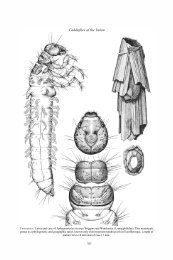Orthopteroids (Orthopteroidea) of the Yukon (V.R. Vickery)
Orthopteroids (Orthopteroidea) of the Yukon (V.R. Vickery)
Orthopteroids (Orthopteroidea) of the Yukon (V.R. Vickery)
Create successful ePaper yourself
Turn your PDF publications into a flip-book with our unique Google optimized e-Paper software.
Orthopteroid Insects (Orthoptera)<br />
<strong>of</strong> <strong>the</strong> <strong>Yukon</strong><br />
VERNON R. VICKERY<br />
Lyman Entomological Museum and Research Laboratory<br />
McGill University: Macdonald Campus, 21 111 Lakeshore Road<br />
Ste-Anne-de-Bellevue, Québec, Canada, H9X 3V9<br />
Abstract. Seventeen species <strong>of</strong> Orthoptera occur in <strong>the</strong> <strong>Yukon</strong>. One species, Bruneria yukonensis <strong>Vickery</strong>, is<br />
endemic. Most species have affinity with Palaearctic relatives and some genera are Holarctic. The present<br />
occurrence <strong>of</strong> nearly all <strong>of</strong> <strong>the</strong> species has been strongly influenced by land bridges between Asia and North America<br />
and by Beringian refugia.<br />
Resume. Les insectes orthoptéroïdes (Orthoptera) du <strong>Yukon</strong>. Dix-sept espèces d’orthoptères vivent au <strong>Yukon</strong>. Une<br />
espèce, Bruneria yukonensis <strong>Vickery</strong>, est endémique. La plupart des espèces ont des affinités avec la faune<br />
paléarctique et certains genres sont holarctiques. La répartition actuelle de presque toutes les espèces a été fortement<br />
influencée par la présence de voies terrestres entre l’Asie et l’Amérique du Nord et par l’existence de refuges<br />
béringiens.<br />
Introduction<br />
Seventeen species <strong>of</strong> Orthoptera have been recorded from <strong>the</strong> <strong>Yukon</strong>, 14 acridid<br />
grasshoppers (Acrididae) and 3 pygmy grasshoppers (Tetrigidae). One species <strong>of</strong> Orthoptera,<br />
Bruneria yukonensis (Frontispiece), is endemic in <strong>the</strong> <strong>Yukon</strong>. Representatives <strong>of</strong> <strong>the</strong><br />
Orthoptera occur all over <strong>the</strong> world. Most species are primarily tropical or subtropical but<br />
some are adapted to temperate regions. Very few species are known from <strong>the</strong> arctic.<br />
A single species <strong>of</strong> cockroach, Blattella germanica (Linn.), <strong>the</strong> common German<br />
Cockroach, also manages to survive in heated buildings and breeding is continuous. It could<br />
not survive without this protection. It has become established in many nor<strong>the</strong>rn locations in<br />
buildings in Iceland, Greenland, Alaska (Pribil<strong>of</strong> Islands), in Canada at Alert, Ellesmere<br />
Island, as well as various o<strong>the</strong>r nor<strong>the</strong>rn localities, including some in <strong>the</strong> <strong>Yukon</strong>. As it is<br />
only adventive it will not be discussed fur<strong>the</strong>r in this paper.<br />
The species <strong>of</strong> Acrididae in <strong>the</strong> subarctic have life cycles lasting one or 2 years or more.<br />
Those that are univoltine pass <strong>the</strong> winter in diapause in <strong>the</strong> egg stage; semivoltine species<br />
pass <strong>the</strong> first winter as eggs and <strong>the</strong> second as third- or fourth-instar nymphal hoppers,<br />
maturing in <strong>the</strong> following spring. Under nor<strong>the</strong>rn conditions <strong>the</strong> eggs <strong>of</strong> some species may<br />
not hatch until <strong>the</strong> third spring season (see Kreasky 1960). The Tetrigidae have, so far as is<br />
known, univoltine cycles but winter as adults and produce a new generation that becomes<br />
adult before winter. This type <strong>of</strong> cycle is not confined to nor<strong>the</strong>rn regions but also is common<br />
in temperate regions. In <strong>the</strong> tropics and subtropics breeding may be continuous, producing<br />
a number <strong>of</strong> generations each year, or may be interrupted by aestivation during hot or very<br />
dry conditions.<br />
Materials and Methods<br />
Specimens have been examined over a period <strong>of</strong> years from <strong>the</strong> following institutions:<br />
Canadian National Collection, Ottawa, Ontario (CNCI); Royal Ontario Museum, Toronto,<br />
pp. 223 – 239 in H.V. Danks and J.A. Downes (Eds.), Insects <strong>of</strong> <strong>the</strong> <strong>Yukon</strong>. Biological Survey <strong>of</strong> Canada (Terrestrial Arthropods),<br />
Ottawa. 1034 pp. © 1997
















